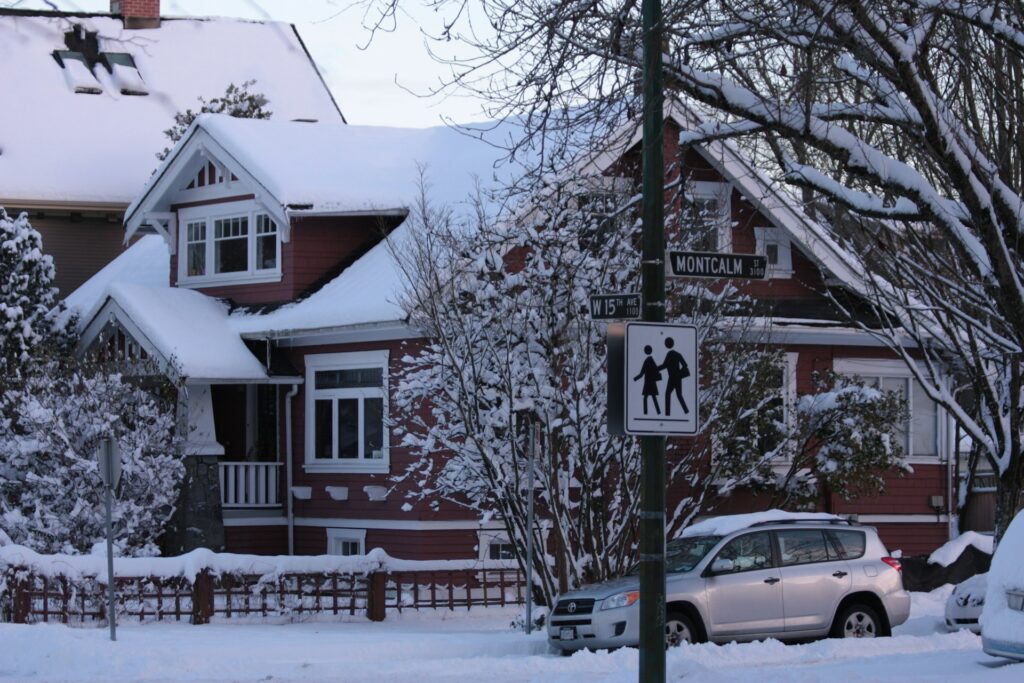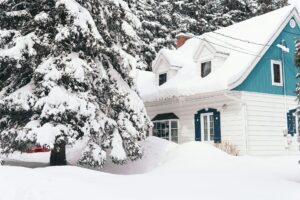Vancouver’s winter months can bring gusty Columbia Gorge winds, heavy rainfall, and sudden cold snaps. Between November and March, homeowners in Southwest Washington experience storm cycles that test a roof’s durability again and again. A small leak or a few loose shingles may seem harmless during a mild day, but once a powerful storm sweeps in from the east, significant roof damage can quickly become a reality. Early preparation – especially before November – can mean the difference between a dry, safeguarded home and an urgent repair during the height of storm season.
In this guide, we’ll explore Vancouver’s unique climate challenges and offer step-by-step insights on how to protect your roof from wind, rain, and winter wear. By the end, you’ll be ready to schedule your free roof inspection and confidently face the Pacific Northwest’s winter storms.
Vancouver’s Unique Winter Storm Pattern
Vancouver, WA, sits just north of the Columbia River and experiences stark weather influences due to the Columbia Gorge. This natural corridor funnels wind from eastern Washington through to the Portland-Vancouver metro area. During winter, cold air travels through the gorge, colliding with milder, moisture-laden fronts coming off the Pacific Ocean. The result can be dramatic: considerable gusts, swirling rain patterns, and occasional localized snow.
These seasonal pressures put roofs under a unique strain. According to the National Weather Service’s Columbia Gorge wind patterns and storm data, gusts can easily exceed 50 mph. When strong lateral winds combine with heavy precipitation, areas like ridge caps, flashing, and roof valleys shoulder the impact. If shingles are aging or were improperly installed, strong winds may loosen or lift them, paving the way for water intrusion.
Vancouver homeowners sometimes overlook how quickly a single storm can turn into a prolonged episode of wind-driven rain. The key to preventing damage is paying attention to structural details. Reinforced flashing, properly secured ridge caps, and well-sealed valleys can all mitigate moisture infiltration. Being aware of the forces at play is the first step in preparing your home effectively.
November-March Storm Cycles in Southwest Washington
While storms can strike any time, November through March is the crucial window for Vancouver and its surrounding communities. Early in the season, temperatures can quickly drop overnight, transforming rain into sleet or icy conditions. Later into January and February, the persistent pattern of soaking rains can leave roofs susceptible to hidden leaks.
Local forecasts from the National Weather Service Vancouver often note multiple back-to-back weather fronts during these months. This can mean one storm system scarcely departs before the next one arrives. Combined with the funnel effect of the Columbia Gorge, the region can get hammered by rapidly moving weather events, each with its own wind gust intensity.
Staying informed about the forecast – especially as the week’s projected weather changes – allows you to schedule a cleaning, maintenance, or quick inspection before a major system hits. Even small tasks completed in mid-November can go a long way in preventing more serious problems that might emerge by February. Many homeowners in older neighborhoods near Vancouver’s historic core or in outlying subdivisions with older roofs have discovered that a pre-winter checkup is a powerful safeguard against bigger headaches later in the season.
Roof Vulnerabilities Specific to Vancouver’s Climate
The combination of brisk, wet Pacific Northwest conditions and gusty gorge winds exposes roofs to an array of potential problems. Here are a few vulnerabilities to keep in mind:
- Shingle Lift and Curl: High winds often catch the edges of asphalt shingles. If they’re even partially loose, repeated gusts can curl or tear them off. Once a shingle is missing, the chance for water to seep in increases exponentially.
- Flashing Fatigue: Flashing around chimneys, vents, and skylights is a common failure point in windy climates. Vancouver’s experienced storm-protection roofing team often sees flashing that’s begun to lift or warp after only a few seasons of powerful gorge winds.
- Valley Overflows: Roof valleys handle significant water runoff. In Vancouver’s climate, where storms can drop large amounts of rain quickly, debris buildup in valleys may lead to water overshooting gutters or finding its way under roofing materials.
- Soaked Insulation and Attic Issues: Even small leaks, if left unchecked, can result in mold growth or compromised insulation in your attic space. With months of near-constant dampness, minor moisture penetration can expand into a major structural concern.
If your home needs support in any of these areas, exploring our comprehensive storm damage assessment process offers guidance on potential vulnerabilities so that they can be remedied before storms peak. These small repairs and reinforcements avert high-cost fixes down the line.
Wind Damage Prevention and Inspection Points
When it comes to wind preparation, investing a bit of time and resources now can help you avoid costly roof repairs later. Wind-lifted shingles, missing nails, and cracked roof vents are often invisible from the ground. A thorough inspection ensures minor weaknesses don’t become big problems during the next gale.
Key inspection points:
- Shingle Integrity: Look for cracked, curled, or missing shingles, especially along the edges of roofs where winds first hit.
- Ridge Caps Security: These caps along the peak of the roof usually take the brunt of forceful gusts, so verifying they’re securely nailed or fastened is crucial.
- Flashing: Ensure the metal flashing around penetrations is securely installed and free of rust, gaps, or bending. Loose flashing is a frequent point of water intrusion.
- Attic Ventilation: Wind-driven rain can infiltrate vents if screening or flashing around them is worn or missing.
According to manufacturer wind rating specifications, many asphalt shingles can handle winds up to 90-110 mph if properly installed. However, even the best materials fail if original installation wasn’t done correctly or if they’ve deteriorated over time. A thorough check can uncover these hidden issues.
For more in-depth wind-protection advice, see our wind damage prevention strategies. A few proactive measures may be all you need to ensure your roof remains unscathed through winter’s worst.
Heavy Rainfall Preparation: 40+ Inches Annually
Vancouver commonly sees more than 40 inches of annual rainfall, with a good portion arriving in steady downpours through late fall and winter. This abundant precipitation can test a roof’s drainage and highlight any misalignment between roofing and gutter systems.
Key considerations for rain readiness:
- Gutter Clean-Out: Leaves, needles, and roofing granules can accumulate, increasing overflow risks. Clogged gutters can direct water back under shingles or drip down siding.
- Downspout Efficiency: Make sure your downspouts move water away from the foundation. In southwestern Washington’s soggy soils, inadequate drainage can cause water pooling near footings.
- Check for Pooling: Flat or low-slope roof sections should be free of standing water. Persistent pooling not only accelerates shingle decay but also increases leak risk.
- Moss and Algae: The damp environment can foster moss growth, loosening shingles and adding weight to the roof structure.
Setting aside time for an annual or semi-annual gutter cleaning can deter a host of water-related problems. Pairing this with a quick inspection for roof surface issues fosters a well-rounded approach to rain mitigation. Many homeowners treat gutter cleaning as a once-a-year chore, but given the volume of rainfall in Vancouver, a check in late fall and another in mid-winter can help maintain optimal flow.
Storm Readiness Levels: DIY vs. Professional
Determining how extensively to prepare your roof depends on your budget, the roof’s age, and exposure to high winds. Basic DIY Prep might involve a weekend afternoon on the ladder removing debris, checking for missing nails, or replacing the occasional cracked shingle. This is a good starting point, especially for newer roofs still under warranty. However, a professional inspection adds peace of mind: trained Vancouver roofing contractors can spot subtle weaknesses, especially for roofs older than a decade.
Comprehensive storm-proofing typically combines an inspection with reinforced flashing, re-securing ridge caps, and potentially upgrading your attic ventilation. These approaches proactively address deeper vulnerabilities so they can stand up to repeated heavy wind and rain. If you live near the western edge of the gorge or in direct wind channels, investing in a higher level of readiness can save you expensive mid-winter emergency calls.
Don’t wait for the first major storm to test your roof. HomeMasters’ Vancouver team offers free storm-readiness inspections with same-week availability. Protect your home before winter hits. Schedule Free Inspection
Valley and Flashing Inspection: Highest Leak Risk Areas
Roof valleys and flashing are more prone to leaks than almost any other area – especially in a region consistently buffeted by wind-driven rain. Roof valleys act as highways for runoff, funneling water down your roof’s lowest slopes. If these channels are clogged or the valley lining is compromised, water can seep underneath shingles.
Meanwhile, flashing acts as protective metal barriers where the roof meets chimneys, walls, skylights, or vents. Over time, flashing can corrode or pull away from the roof deck, allowing wind-driven rain to slip behind it. Catching this early is crucial because:
- Once flashing lifts or rusts, water infiltration accelerates.
- Minor expansions or contractions (especially in freeze-thaw cycles) exacerbate existing cracks.
- A valley clog or tear can quickly escalate into a major roof leak during heavy storms.
When you hire Vancouver’s experienced storm-protection roofing team for an inspection, they’ll pay particular attention to these high-risk areas. Timely repairs or replacements of flashing and valley linings often give you one of the best returns on investment in terms of preventing leaks.
Emergency Storm Preparation Essentials
Pacific Northwest storms can intensify with little warning. Having an emergency plan protects your home and your family if the worst occurs. Emergency preparation includes:
- Roof Tarp or Plastic Sheeting: Tools like tarps and water-resistant plastic sheeting can slow water intrusion until a professional arrives.
- Flashlights and Backup Lighting: If strong winds cause power outages, ensure you have a reliable source of light to inspect for leaks indoors.
- Containment Supplies: Buckets and towels can help manage roof drips. Locate them before a storm starts, so you aren’t searching in the dark.
- Contractor Numbers Handy: Keep contact information for emergency roof repair procedures for Southwest Washington in an easily accessible spot (phone or written down) to avoid stress if a system hits unexpectedly.
- Photo and Video Documentation: If damage occurs, documenting water intrusions helps with insurance claims. Staying organized reduces your recovery time.
Scenarios like unexpected leaks often feel daunting in the moment. But being prepared to act quickly – and knowing who to call – is half the battle. If your roof does suffer storm damage, never attempt a repair in extreme conditions. Focus on mitigating interior damage and scheduling a professional from HomeMasters for a thorough assessment once weather conditions allow.
Long-Term Storm-Proofing Solutions vs. Short-Term Patches
When debate arises between quick fixes and more substantial reinforcements, it’s wise to weigh your roof’s age, past history of leaks, and the severity of Vancouver’s storms. Sometimes, a simple patch will hold for the rest of the season – but a patch may fail under repeated high wind cycles or torrential downpours.
Short-term patches:
- Tend to be inexpensive initially, making them appealing to homeowners looking to solve immediate leaks.
- Provide limited security if the overall roof structure is compromised in other areas.
- May recur as future leaks if the underlying condition causing the problem remains unaddressed.
Long-term solutions:
- Start with a professional inspection, identifying hidden weaknesses before they become roof-wide issues.
- Often include resecuring or replacing large sections of shingles, reinforcing flashing, and ensuring robust attic ventilation.
- Offer peace of mind that your home is prepared for repeated storms now and in future seasons.
The moderate climate in Vancouver can be deceptive when storms aren’t at their peak. However, the next big weather event can swiftly arrive. Investing in a thorough step-up to comprehensive, long-term solutions may save you from repeated patch bills, emergency calls, and water damage repairs that can destabilize your home’s interior over time.
10 FAQ: Vancouver Winter Storm Roof Questions Answered
Below are answers to the most frequent concerns local homeowners have about dealing with winter storms.
- How do I prepare my Vancouver roof for winter storms specifically? Clear all debris from roofs, valleys, and gutters to keep water moving freely. Inspect flashing around penetrations, test shingle adhesion – Columbia Gorge winds can reveal weak spots. Verify gutters handle the 40+ inches of annual rainfall. For peace of mind, consider a professional roof inspection that uncovers hidden problems.
- What roof damage do winter storms cause in Southwest Washington? Wind-lifted shingles, ridge cap blow-offs, flashing failures, valley overflow, gutter separation, and penetrating leaks from driving rain are the most common. Storm cycles often worsen minor damage over time, resulting in bigger repair bills if not addressed promptly.
- Do I really need a roof inspection before winter in Vancouver? Absolutely. Especially if your roof is over 10 years old, if your home faces the Columbia Gorge’s east/northeast winds, or if you haven’t had an inspection in over two years. November is ideal – before more extreme storms set in.
- How much wind can my Vancouver roof realistically withstand? Properly installed asphalt shingles can endure 90-110 mph winds, based on understanding your roof’s wind rating. However, repeated gusts of 50-70 mph common in Columbia Gorge storms can exploit existing weaknesses like loose nails or deteriorated seals. Professional checks ensure your roof is prepared.
- What should I do if my roof leaks during a winter storm? Contain water inside using buckets and plastic sheeting to protect floors and belongings. Avoid climbing onto the roof in dangerous conditions. Document damage with photos or video, then call HomeMasters’ emergency line. Our emergency guide details the best steps until we can address the issue in a safe environment.
- Are there financing options for pre-winter roof upgrades in Vancouver? Yes. HomeMasters offers flexible financing plans so vital storm-proofing or a full roof replacement isn’t delayed by budgeting concerns. Speak with our financing team to tailor a payment plan that meets your needs and timeframe.
- How is Vancouver different from Portland for roof storm preparation? While close geographically, Vancouver sees a stronger direct influence from Columbia Gorge winds, creating more dramatic wind patterns than Portland. Additionally, slightly higher rainfall totals contribute to greater demand on flashings, gutters, and shingles. This means Vancouver roofs typically need more robust wind and water reinforcements.
When to Schedule Your Free Inspection
An annual checkup can help limit long-term damage by highlighting developing problems before they morph into emergencies. Once November arrives, winter storms approach rapidly. Book an inspection in the fall to ensure your roof stands up to the colder, wetter months that lie ahead.
If you’ve noticed any signs of roof wear – like missing shingles, water stains in the attic, or gutter overflow – contact Vancouver’s experienced storm-protection roofing team at HomeMasters for quick assistance. Even if you haven’t spotted anything amiss, state-of-the-art roof scanning and thorough on-site checks can detect hidden leaks or material shortcomings.
Final Thoughts on Safeguarding Your Vancouver Roof
Vancouver’s late fall and winter months deserve respect. Windy blasts funneling through the gorge repeatedly test your roof’s structural resilience, while rain accumulation taxes the drainage system. Thoughtful preparation – from clearing gutters to investing in new flashing – can make all the difference in staying safe and dry throughout the stormy season.
Winter roof readiness doesn’t have to be stressful. Address vulnerabilities in advance, keep emergency supplies on hand, and consider a professional storm-readiness inspection. By taking a proactive stance, you’ll be prepared for whatever Mother Nature throws your way.
Vancouver winter storms are coming – is your roof ready? Contact HomeMasters at for your free storm-readiness inspection. November appointments are available now before the weather deteriorates.




